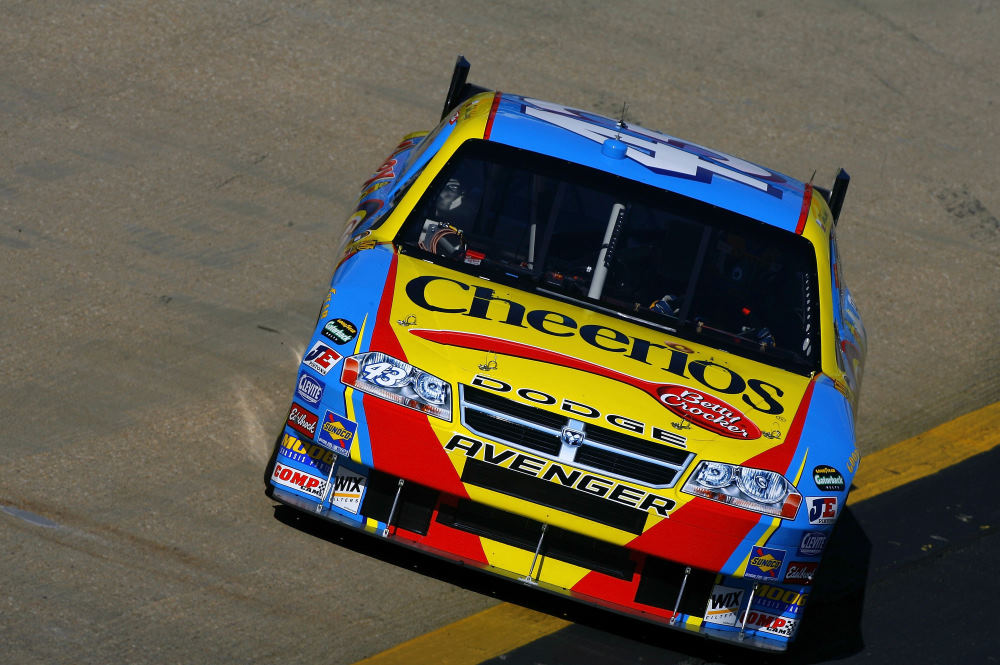COT cars get high marks at Bristol test
 With engines revving and crew members scurrying in the garage, Wednesday’s first day of NASCAR NEXTEL Cup Series testing at Bristol Motor Speedway looked typical rather than ground-breaking. All photos courtesy of Dodge/Getty Images
With engines revving and crew members scurrying in the garage, Wednesday’s first day of NASCAR NEXTEL Cup Series testing at Bristol Motor Speedway looked typical rather than ground-breaking. All photos courtesy of Dodge/Getty Images
But with the morning sun creeping over skyboxes, Kurt Busch (No. 2 Miller Lite Dodge) officially kicked off a historic day – driving the first Car of Tomorrow to take the track at 9:20 a.m.
 This week’s two-day session is in advance of the Food City 500 on March 25, the first event where teams will compete with their Car of Tomorrow model. Fifty teams were scheduled to test Wednesday and Thursday at Bristol.
This week’s two-day session is in advance of the Food City 500 on March 25, the first event where teams will compete with their Car of Tomorrow model. Fifty teams were scheduled to test Wednesday and Thursday at Bristol.
“This is an interesting day," said Jeff Burton (No. 31 Cingular Wireless Chevrolet) of Wednesday’s session. “I've never seen such a big change, you know, happen in NASCAR. We're all here at the same time trying to figure it out. People are going to leave here with ideas and come back with other ideas based on what they learned here."
The March event at Bristol is the first of 16 this season slated to be run with the Car of Tomorrow. A seven-year project by NASCAR’s Research & Development Center, it features significant safety enhancements, including a larger cockpit, double frame rail with steel plating, energy-absorbing materials in the side and a safer fuel cell. The car also features improved competition, better cost management for teams and increased manufacturer identity.
“The first thing about it is the car is safer," said Daytona 500 champion Kevin Harvick (No. 29 Shell/Pennzoil Chevrolet). “Whatever it is after that is a bonus. The drivers have more room inside. There are a lot of things built into the car to absorb energy when they hit the wall. That's just the starting point."
Visually, the Car of Tomorrow has two new, noticeable components: A front “splitter" that slices through, and catches air, and a rear wing instead of a spoiler. Both aerodynamic pieces are adjustable, which gives teams two easier-to-operate, more-efficient tools.
Reigning series champion Jimmie Johnson (No. 48 Lowe’s Chevrolet), fifth-fastest in Wednesday morning’s session, said he’s learning the racetrack feel of the splitter.
“I can feel it getting into the corners," Johnson said. “In the past a lot of drivers would dip their left front tire under the yellow line on corner entry to help the car rotate. Now you can feel the splitter; it's sticking out a little further than what we're used to. You can feel it touching. I had to alter my line into Turn 1 just a little bit. Nothing major."
Inspection: A Learning Process For Car Of Tomorrow … Aside from on-track work, this week’s Car of Tomorrow test at Bristol Motor Speedway also has another component – inspection. A new car means a new process of inspecting it, and NASCAR NEXTEL Cup officials were ready early Wednesday when the garage opened. Inspection wasn’t mandatory, but available to teams wanting to refine and reassure.
“We’re taking the time to walk all the way from A through Z through the entire template process," said NASCAR NEXTEL Cup Series director John Darby. “Actually it’s educational for our own officials as much as the teams, but we’re letting the two groups work together to trouble-shoot the system."
Like the current inspection process, Car of Tomorrow inspection will concentrate on exterior body measurements and templates, but with a twist: Rather than the current template bay with multiple templates that must be applied by hand, a new scaffolding-like structure allows multiple templates to be applied to a car at the same time. It was a popular station during Wednesday morning’s inspection, with its gleaming, retractable aluminum templates that inspectors lower from above.
“The value of being here and working with the teams on the process is to help everyone understand the issues," Darby said, “and to expedite the process when we come back."
Prior to competing, teams must present their Car of Tomorrow chassis and roll cages for certification at NASCAR’s R&D Center in Concord, N.C. At the track, they must verify that their car has been certified. Darby – who said the NASCAR NEXTEL Cup garage will open a day early during March race week – was pleased with both the tenor and pace of Wednesday’s inspections.
“I don’t think we’ve seen anything that’s been a surprise," he said. “I don’t think we’ve seen anything that’s been out in left field if you will. It’s been more a refining process with the teams than anything." NASCAR PR
